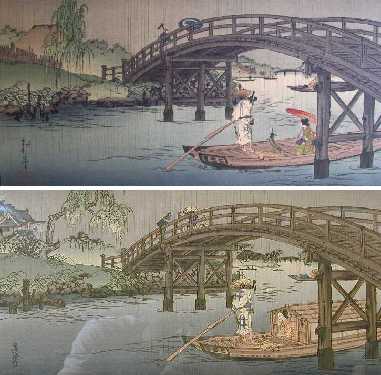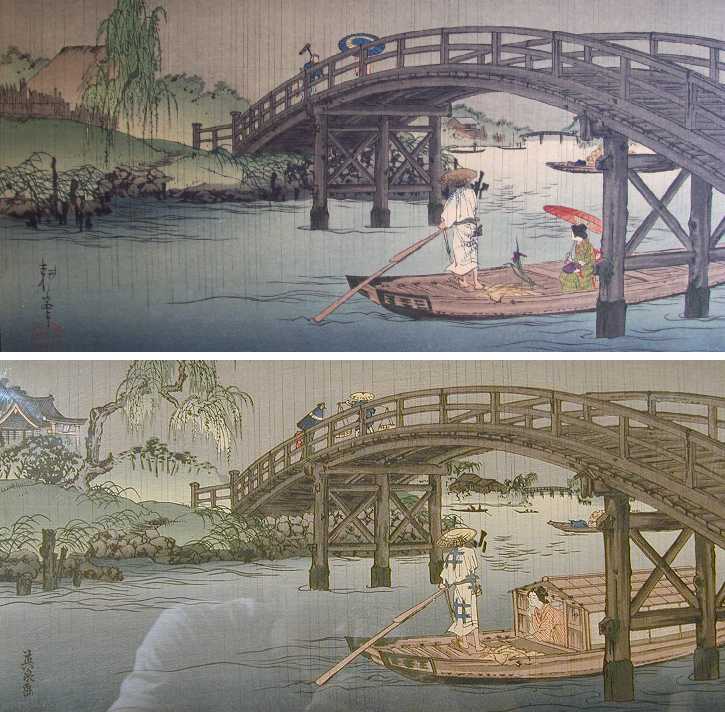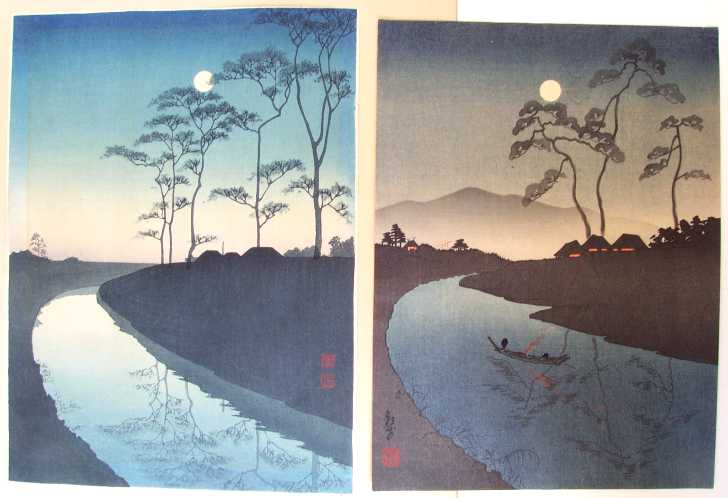
Koho's ca1910-20's "A Bridge in the Rainy Season" print seen above a "Look-Alike" Print (ca1910-30's)

"Still MORE Look-Alike" Prints.... A Few Further Examples
Continuing with our earlier Ukiyoe-Gallery.com Article #42,
"Look-Alike" Prints of the Early "Shin-Hanga" Era,"
and Article #44,
"MORE Look-Alike" Prints of the Early "Shin-Hanga" Era,"
we will now examine three additional interesting examples of "look-alike"
prints of the early 1900's "shin-hanga" era. As with our previous examples, encounters with these prints
provide a fascinating study--and while we will likely never know the full story of their evolution and production, it
continues to be an endlessly fascinating pastime to recognize and study these prints.
As previouly then, armed with some knowledge prints, some reasonable assumptions, and a bit of common sense,
we can then make some rational speculations as to the evolution of these prints. Without again repeating many of the
reasoned speculations of our prior two articles, let's now move on to some further examples.
Koho's "A Bridge in the Rainy Season" and a "Look-Alike" Print
As this article's first example, we will now present a strikingly similar and interesting "look-alike" copy of Koho's
"oban-sized" (9 x 14 inch)
image titled "A Bridge in the Rainy Season." This rarely encountered scene of old Japan
was published by Hasegawa Publisher, who is perhaps best known for their chuban-sized (7 x 10 inch) series of 21
"Night Scenes" prints produced during the early
1910-20's period. Of the same vintage, our subject print "A Bridge in the Rainy Season" is listed in the early
1920's "Hasegawa Catalogue" and is seen just below on the left. Our "look-alike" print is one that we have only
examined via digital images, sent to us several years ago by a viewer (hence, we apologize for the minor
"reflection" seen in this image).


Koson's 1910-23 "Scops Owl on Branch, Full Moon" Print and Kono Bairei's "look-alike" Print
As this article's second example, we will now present a recently encountered "look-alike" that came as even a surprise to us. Viewed as
an offering in a recent December on-line auction was a print that immediately caught our eye. The well-known 1933 nighttime Hasui street
scene titled "Evening at Soemoncho, Osaka" of which many viewers are already familiar, in fact it seems, has a "look-alike" copy. Although
we were unfortunately not able to view the "look-alike" print firsthand, we will show and tell you what we can. Both prints are seen just below.


Koho SHODA's 1910-20 "A Country Scene" Print and an unknown artist's "look-alike" Copy
As our third and final example, we present below a well known
"Night Scenes" print by Koho SHODA titled "A Country Scene,"
and a cute little "look-alike" print that recently caught our eye. This quite similar print is unquestionably a deliberate
modification of the popular "Country Scene" print, with a nearly identical overall design and layout of elements. Same
(we really mean "similar") curvature of the canal, same reflection, same three little rooftops, same general placement
of trees, and same location of the moon.
About all that's really different is the "look-alike" print's addition of a little boat and the addition of distant
mountains. No matter which print one's eyes are drawn to, in both cases it is an enjoyable experience. Full images
of both these prints are seen just below.

A Few Concluding Remarks
These three additional examples of a "look-alike" prints (in what has been to date our third article on this topic
of "look-alike" prints) have been presented to our readers for both their education and their entertainment. Time spent
carefully and thoughtfully viewing prints such as these, we believe, can offer much to the collector who is willing to
take the time to do so. And the rewards can be great....
As perhaps is the case with all "art," the primary intention of its creator (the artist) is to
transport the viewer to another place, to another time, or simply to another mind-set other than the viewer's
present reality. If the viewer of a piece of art then finds--even for a brief few moments--that the concerns of the
present are forgotten,
then we must conclude that the artist was indeed successful.
As a final thought, it remains our continuing assertion that present-day collectors of "shin-hanga" prints CAN still
today discover new insights and make contributions to the collective study of "shin-hanga" prints. Needed only
is a willingness to look beyond the obvious,
the open-mindedness to question "what is known," and a simple passion to learn and discover more.
Enjoy your prints, and enjoy your journey.
Please Let Us Know.....
Please shoot us an email at Ukiyoe Gallery and let us know if you've enjoyed these two
articles on "Look-Alike Prints." We can certainly add a few
further interesting examples if our readership's interest is sufficiently strong to warrant doing so.
Literature (and print) sources used in preparation of this and other articles include:
Above documented prints courtesy of: Ukiyoe-Gallery
Shotei.com website, by our good friend, Marc Kahn (Vancouver, WA)
"Guide to Modern Japanese Woodblock Prints: 1900-1975", by Helen Merritt and Nanako Yamada, University of Hawaii Press, Honolulu, ISBN 0-8248-1732-X
"Kawase Hasui -- The Complete Woodblock Prints", by Kendall H. Brown & Shoichiro Watanabe, Hotei (KIT) Publishing, Netherlands, ISBN 90-74822-46-0
"Crows, Cranes and Camellias: The Natural World of Ohara Koson", by Amy Reigle Newland, Jan Perree, Robert Schaap, Hotei (KIT) Publishing, Netherlands, ISBN 90-74822-38-X